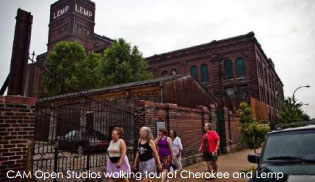Develop a Neighborhood Walking Tour & Market Your Neighborhood
Host themed walking or biking tours of your neighborhood to encourage urban exploration, active lifestyles, and to offer unique insight to your neighborhood for residents and visitors.
Description

Host themed walking or biking tours of your neighborhood to encourage urban exploration, active lifestyles, and to offer unique insight to your neighborhood for residents and visitors. Examples themes are sustainable backyards, unique homes, green buildings, historic buildings, churches, local businesses, parks, schools, haunted houses, places for kids, etc. Marketing and branding your neighborhood can have a dramatic impact on the perception and actual quality of life for residents, visitors, and business owners. Introduce a unique design, logo, and or slogan that gives an identity to your neighborhood and capitalizes on good and unique qualities.
Related Tools
When paired with other tools, walking tours, marketing, and branding can contribute to a greater and more holistic, sustainable neighborhood. Think about community cohesion, active lifestyles, public art, and local prosperity. Try combining this strategy with:
Community Projects
Add your project
Neighborhood Benefits
Environmental
- Tours to promote historic preservation or sustainable activities and design features
- Walking and biking to promote sustainable transportation choices
Social
- Increased knowledge, respect, and investment in your neighborhood
- Highlighted successes that create community solidarity
- Marketing and branding that build a common neighborhood vision to unite neighbors
- Unique qualities highlighted to preserve local culture
Economic
- Buildings are preserved and future redevelopment is encouraged
- Investment and promotion for development in the neighborhood
- Marketing and branding that promote local spending and local investment
Get Started
- Research A tour and marketing strategy will serve residents and visitors best by highlighting what makes your community exciting and special compared to other neighborhoods. Research and brainstorm with your neighborhood association, long-time residents, youth, and other community organizations about ideas for tours. Visit your library for books about the history of your neighborhood. You can host a community event to get input, conduct a survey, or talk casually with neighbors. Some St. Louis neighborhoods already have tours, so be sure not to duplicate one that already exists.
- Plan Establish a theme for your tour. Ideas include sustainable backyards, historical buildings and sites, tours for kids, community gardens, churches, public art, local specialty shops (antiques, breweries, artisan foods, etc), architecture, and home open house tours that showcase houses for sale or newly renovated. Some existing tours include Shaw on Show, FPSE Rehabbers Tour, and Annual Old North House & Community Tour.
- Create Create the tour. Map out the route for walking or biking and write and rehearse the information you or your tour host will be presenting. If you are not hosting, ask an exciting expert or long time resident to volunteer their time. You can also work with an established organization such as a museum, a community group, or an existing tour group such as Renegade Tours STL, Metropolis Downtown Architectural Walking Tours, or St. Louis Walking Tours.
- Schedule & Advertise Choose a date and time, then advertise your tour. Use your local paper, a neighborhood association newsletter, flyers, a website, and word-of-mouth. Walking/Bike tours can be free, by donation, or by a small cost. If led by volunteers, donations could go toward maintaining a website or creating printed material.
- Share Information Create a printed card or guide as a take home for tour guests so they remember their experience and are encouraged to participate in future tours. You can also make self-guided tours and put the information online via a map and typed information or a recorded speech for download. A donations button on the website could help raise money.
- Market Take a similar approach to marketing and highlight all the most special things about your neighborhood. Branding and marketing can have an incredible impact on the perception of your neighborhood, economic development, individual investment, and pride from neighborhood residents. Marketing is most successful when your neighborhood already has organized leadership, a reasonable sense of security, and a revitalization strategy. To begin the marketing and branding process, these online resources provide a good starting point:
- Examples Neighborhoods and districts such as South Grand, Benton Park, Old North, Covenant Blu/Grand Center, and Midtown Alley are examples of neighborhood branding success stories. Shaw is going though the process now as well.
Related Categories
Sustainability Plan Categories
Project Scale
- Block
- Neighborhood
- Park
- Public Building
- Street
Download This Tool
Develop a Neighborhood Walking Tour and Market Your Neighborhood Doc (295.67 KB pdf)
Need Help Viewing?
You need a program that can open Adobe PDF files. A free option:
- Adobe Reader can read PDF files